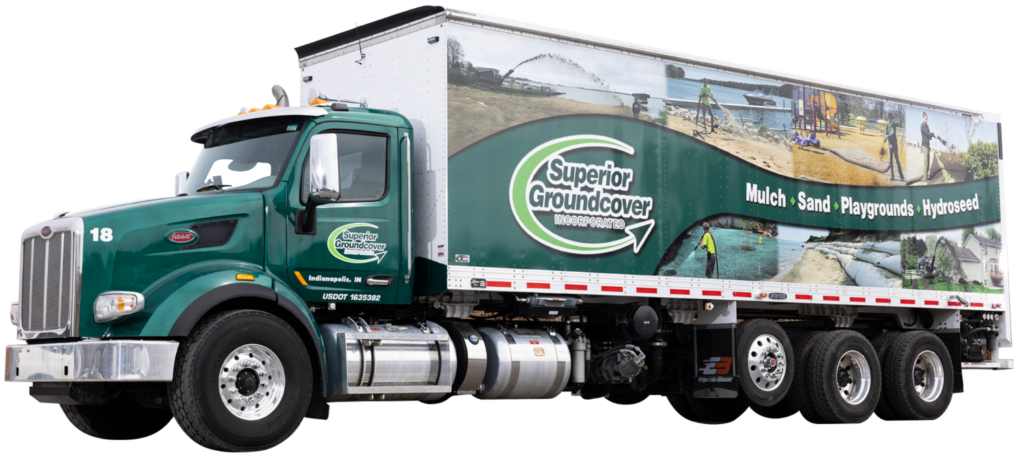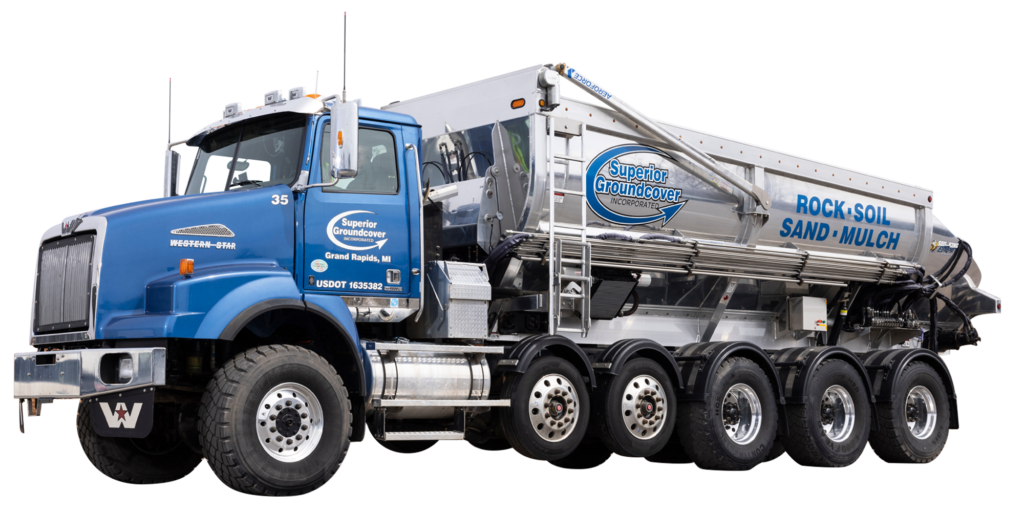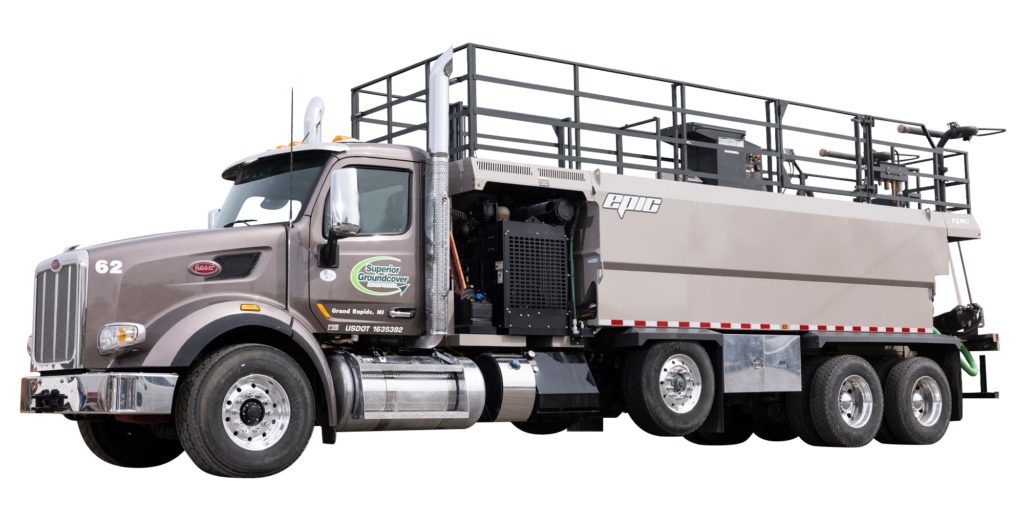Weeds are a relentless challenge for both commercial and residential landscapers. They can turn your beautifully crafted landscapes into an eyesore in what feels like the blink of an eye.
Instead of fighting with weeds, get ahead of weed growth by using bark and mulch for weed control. Both provide a proactive, natural solution to keep weeds away while improving the overall health of the soil and plants.
How Bark and Mulch Work as Proactive Weed Control
Bark and mulch are much more than finishing touches to your landscaping projects. They also serve as proactive weed barriers that create a healthier growing environment for plants and make weed management a breeze.
Here’s how bark and mulch work their magic to stop weeds in their tracks:
- Create A Physical Weed Barrier: A thick layer of bark or mulch makes it difficult for weeds to break through. This hinders weed seeds from germinating or ever making it past the soil surface.
- Improve Soil Health: Organic mulch decomposes over time, adding nutrients to the soil. Healthier soil means stronger plants that can outcompete weeds.
- Retain Moisture: Mulch retains moisture, keeping plants and groundcover hydrated, which again helps them outcompete weeds.
- Block Sunlight: Weeds rely on sunlight to germinate and grow. Mulch blocks out much of the light, making it harder for weeds to establish themselves.
- Maintain A Stable Soil Temperature: By insulating the soil, bark and mulch keep the soil at a consistent temperature. This is good for established plants, which makes it harder for weeds to grow.
The Best Landscaping Materials for Weed Control
When it comes to weed control, both bark and mulch have their strengths. The best choice depends on the specific landscape, environment, and aesthetic goals of your project.
The Two Main Categories of Landscaping Materials for Weed Control:
Most people automatically think of wood chips when they hear the word mulch. However, there are two main groups of mulch:
- Organic Materials (e.g., wood chips, shredded bark, recycled and dyed mulch): Organic mulch is made of natural materials that decompose over time, enriching the soil. This is ideal for gardens, flower beds, and general landscaping.
- Inorganic Materials (e.g., rubber mulch, rocks, stone): These types of groundcover are long-lasting and more durable but they don’t decompose. They are good for high-traffic areas that don’t need the soil enriching properties of organic mulch materials.
If you are trying to prevent weed growth in a vegetable garden, flower bed, farm or even a business with a lot of landscaping, organic mulches are usually the best choice. The most aesthetically pleasing organic options are bark mulch and wood chips.
A Closer Look at the Main Organic Materials: Bark and Mulch
Bark:
- Is made from the outside of trees (tree bark).
- Is fully natural, unless dye is added for richer, longer-lasting color.
- Decomposes faster, providing nutrients for nearby plants
Mulch:
- Is made from wood chips, or the inside of the tree.
- Often includes recycled wood scraps that were previously treated.
- Decomposes slower, making it last longer.
When applied in thick enough layers, 3-4 inches deep for the initial application, both types of organic mulch will reduce weed growth by retaining moisture and providing nutrients to help keep existing plants healthy.
The Best Organic and Inorganic Mulches For Your Project
- Flower Beds and Landscaping Beds: In addition to its beneficial properties for plants, both bark and wood chip mulch provide a clean, finished look that compliment these landscapes’ decorative design.
- Playgrounds: Engineered Wood Fiber (EWF) Playground Mulch is the best option for playgrounds. It is ADA-compliant, durable, and provides excellent drainage, making it ideal for high-traffic play areas.
We don’t recommend rubber mulch due to the chemicals that it leaves in the air and soil. It also makes a mess when it gets tracked inside and gets very hot and smelly in the summer months.
- High-Traffic Areas: If you don’t need the soil enriching properties of organic mulch, rocks and stone are good durable options.
For even more details to help you choose the best mulch for your project, read “What is the Best Type of Mulch for Your Landscaping Project?”
8 Tips for Using Bark and Other Mulches Effectively for Weed Control
To maximize the weed-blocking power of bark and mulch, follow these 8 tips for proper mulch application and maintenance:
- Apply Mulch in Early Spring
For maximum weed suppression, lay mulch or bark chips early in the growing season to prevent weeds from germinating. - Start with a Clean Slate
Before applying a new mulch layer, prepare the soil. Pull weeds that have already poked through. Till the soil to create an optimal environment for plant growth and add compost if the soil needs additional nutrients. - Combine Natural and Alternative Solutions
While bark and mulch are very effective weed control methods, combining them with targeted chemical methods can provide even more comprehensive weed control. You could add pre-emergent weed control to the ground or, if you’d prefer a more natural option, landscape fabric also helps suppress weed growth. - Choose High-Quality Materials
Not all mulch is created equal. Using professionally sourced, high-quality bark or mulch will give you better coverage that lasts longer. Some low-quality mulch has weed seeds and mushroom spores mixed in, causing the very problem you want to prevent!
At Superior, we will apply any mulch that the customer desires. However, premium mulch delivery is part of our blown-in mulch services because we know that top-tier results depend on using the right materials. - Maintain The Proper Mulch Depth
If you want to prevent weeds, you have to lay enough mulch. During the initial application, you’ll need 3-4 inch mulch layers to keep weeds out and moisture in. Deeper layers are required for playgrounds due to the heavy traffic and safety requirements. - Replenish
Keeping mulch at the correct depth is essential for weed control. Mulch needs to be replenished annually (about 1 inch per year) to keep annual weeds from peeking through. - Place Mulch Away from Stems and Roots
Maintain a safe distance between mulch and delicate plant stems or root systems. Placing the mulch too close to your trees and shrubs can cause root rot due to too much moisture. - Check for Weeds and Pests
Even with mulch, occasional weed growth can occur. Stay proactive. Check your landscaping regularly to remove weeds early and prevent infestations. A little bit of hand weeding goes a long way in preventing a weed take-over.
Save Time With Blown-In Mulch Placement
Using mulch is a proven weed control method that looks great. However, manually placing loads of mulch can be tedious and time consuming.
At Superior Groundcover, we know that time is money. Your bottom line depends on efficiency and quality. Our blown-in mulch services are designed to save you and your crew the hassle of manual mulch placement.
Our highly-trained team and advanced fleet of blower trucks can give your landscape that flawless, freshly-mulched look in a fraction of the time.
The Benefits of Blown-In Placement
Blown-in mulch placement is superior for a lot of reasons:
- Fast Placement: We place mulch and bark quickly so you can meet tight project deadlines and stay on schedule.
- Precise Placement: Our specialized equipment helps us get mulch in even the hardest to reach places without causing damage to your clients’ properties.
- Less Manual Labor: You won’t have to waste hours moving mulch. Our services free up your crew to do more profitable tasks while we take care of the entire mulching process.
- Better Weed Control: With our specialized equipment, we can evenly distribute the mulch at the appropriate depth. Since the newly installed material is already compacted down, it prevents air pockets and areas where weeds could survive.
With our blown-in mulch and bark services, you’ll save time, reduce labor costs, and achieve a flawless finish every time. You’ll have high-quality bark and mulch for weed control without all the back-breaking work.
Contact us today to get a free estimate so that you can have more control over those weeds, your project timelines and profit margins.




